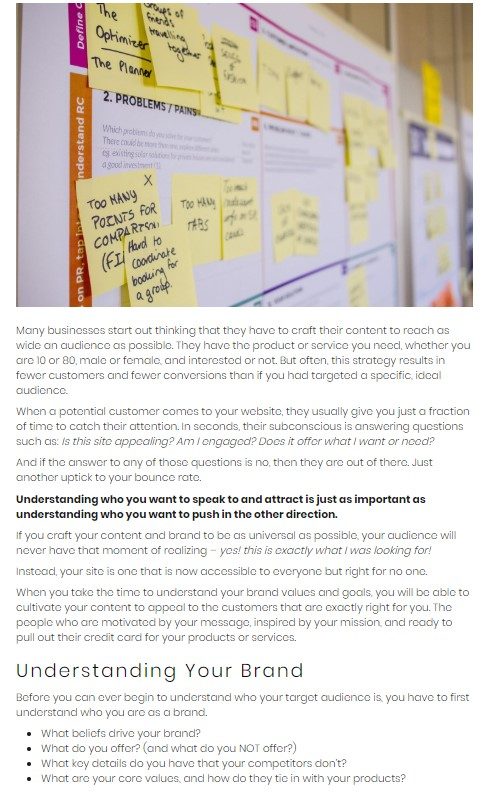Crafting the Perfect Content Strategy

What Does Good Content Look Like, and How Do I Make It?
Content marketing, like writing articles, Youtube videos or podcasts are normal things all businesses are expected to do. The world of marketing has changed in that making stuff to read or watch or listen to is a perfectly valid way to get customers.
To succeed with content marketing today, we need to build content that people understand, like, and feel compelled to consume. We must also be able to create content efficiently and easily so that we can free up our time to work on our business, not just in our business.
So how are we going to do this?
First, you’re going to make a plan. You’re going to decide, in advance, what would be a good content strategy for you and your business.
Step 1 – Enticing Headlines
We’ll start with what your audience is going to see first – your titles, or headlines.
Your title is your decider.
A potential consumer of your piece is going about their business, and they come across your title. If that title is sufficiently compelling to them, they move forward through to the next step in the process. If it isn’t, they don’t.
Searchers might see a title that looks okay, and click. Or they might read the description to confirm that you’re what they’re looking for, and click. Either way, they see the title, and decide if they’re going to take action.
It’s the same for social media, email blasts, YouTube sidebars, and calls to action in your podcasts.
The decider is the title. For most creators, and most consumers, there can be no other contributing information to that first decision, because there is no other information at all.
So what makes a good title?
Here’s a few tips:
- Start with a working title. When thinking of a title, start jotting down the ideas that pass through your head. Think of everything related you possibly can, and write it down. You may think you hit the head on number one, but I promise you the more you write, the better chance of finding a better title.
- Express your main benefit. Your headline is basically an ad for your content that has to convince the audience that your content has the answers they are looking for. If you promise them value in the headline, they will click through to get it.
- Keep it short, simple and to the point. The best headlines get directly to the point. They are not trying to be clever or overly intriguing.
- Get to the point, bring out the benefits and make clear offers. Also, Google cuts off the title after 56 characters!
- Edit with strong language. Go back over your working title and delete passive language. Replace it with strong phrases that pack a punch
Step 2 – Defining Structure
Now let’s look at the next thing they’re going to experience after the title – the structure of the piece itself.
If your title was your decider, structure is your retainer. It keeps your visitors consuming, rather than bailing on your content halfway through.
Once you’ve secured a visitor’s click via your title, you want to make sure you structure your piece in such a way that the visitor’s expectations are met.
The structure of a consumable piece of content is simple, basic, and essentially timeless. When you open a new page and see an endless scroll of text, you can easily be intimidated. It looks like too much to read, and frankly you’re not interested in even trying.
That’s why it’s important to break up your text. Images, subheads, bullet points, numbered lists, and bolded or italicized fonts are all visual cues that keep the eyes scrolling down the page.
Other than that, here are the main elements of an article:
Introduction
Between five and 20 percent of your total content length is devoted to setting up the blog with an introduction. In essence, what your introduction is intended to do is restate your headline promise. However long that takes. An introduction reassures the reader that they are going to get the answer to what the headline promised.
Transition
After the introduction, we use a transition element to pivot the piece towards the rest of the article. A header or subheader is a perfect transition element. So is a numbered or bullet list with a short sentence intro. For each main section of your blog, be sure to use a transitional element.
Body
This is the main copy of the article. It answers all the questions the reader may have, and ensures the promise of the headline. It can be 500 words, or 2000 words. There is no magic number when it comes to blog writing. As long as you are consistent and fully answer the question, the length is perfect.
Closing
This is where we tell readers, “By the way? We’re done now.” There are many ways to close an article. One is to offer a quick summary of the piece. Another is to close with a call to action to direct them further into your site. And a third is to close with a repetition of your introduction.
Just as with titles, getting the hang of structure doesn’t take long to get used to. Practice it a few times, and it will become second nature.
Step 3 – Timing
You’ve finally landed on a great title, and you’ve made it through writing your blog. So…when are you supposed to publish it? Is there a magic day or a magic time? Let’s jump in.
Your title was your decider. Your structure was your retainer. Your timing is your optimizer.
There’s a lot of misinformation floating around out there about when you should publish, release, or promote your content.
Choosing a time to publish your content is definitely important, but there is no “magic hour” that will send your content to the first page of Google results.
It is the third important aspect out of our three steps. If it has a bad title, it won’t get clicked. If it has bad structure, readers won’t make it to the end. But an article promoted in the middle of the night also won’t get as much traction as it could have.
Badly timed publication or promotion is not the end of the world. But there are times that are better primed for getting eyes. To be clear, here are the definitions for publication and promotion:
Publication is when a piece comes into existence into the world.
Promotion is when you notify your audience of that existence.
Nowadays, if I publish a blog post this morning… and I don’t let you know? You’re not going to find out. You’re only going to find out when I happen to tell you, probably through an email blast, or through social media. So when I publish a piece doesn’t really matter except for my own peace of mind.
When it comes to telling the world, there are some good days, and bad days.
Monday.
Most people are too busy on Mondays in order to engage. They have an inbox full of content and no time for yours. The only exceptions should be for day-specific content (Like holidays or special events).
Tuesday.
Pretty much the best day for anything, I almost always default to publishing content on Tuesdays.
Wednesday.
If you’re currently publishing on a Tuesday and you don’t like your engagement rates (opens, shares, comments, etc), try Wednesday instead. It’s almost as good.
Thursday.
If your market is recreational in nature, Thursdays are often even better because they get some momentum in time for weekend social sharing.
Friday.
Nothing good comes from posting on Fridays. The only real exception is content that must run on that day, or if you have garnered audience for a special weekly ritual.
Saturday + Sunday.
Publishing on the weekends pretty much depends on your market. If they are avid weekday readers, you’re not going to do well on the weekend.
What You Should Be Writing
Most content should be simple and intuitive. Health coaches should be writing about tips to staying healthy. Designers should be writing about design tips. Trainers should be writing articles about motivation and getting fit.
It may seem boring, but it is what readers expect of you – writing simple blog posts that they find helpful and useful.
Bells, whistles, and creativity are not required most of the time, and usually, they just get in the way.
For most businesses, customer questions are the same. Most client issues are similar. Most people who are reading your articles or watching your videos or listening to your podcasts are interested in the same kind of stuff. So you shouldn’t be making yourself reinvent the wheel every time you want to make a blog post or shoot a video. You should be making simple, intuitive content, almost all of the time.
So stop thinking hard and reacclimate yourself with simple, intuitive content.
Want to work together on perfecting your content strategy?




